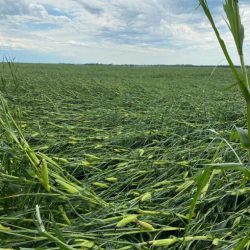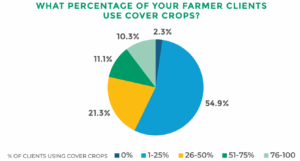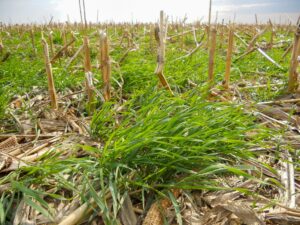By: 4R Plus
September 2020

The double whammy of drought conditions and downed crops due to the historic derecho has some Iowa farmers questioning the feasibility of seeding cover crops this fall, despite their proven benefits. There’s no one-size-fits-all approach to navigating difficult conditions, but Mark Licht, Extension cropping systems specialist with Iowa State University, has some insights for farmers to help them move forward.
”Weather has delivered a blow to the farming community across the state and we’re all trying to manage through – like we do every year – but on a larger scale for many,” said Licht. “Soil conservation may not be the top priority for farmers after difficult weather conditions, but practices like no-till and cover crops are starting to show value at the farm level, so it’s critical to keep the momentum going.”
After an extended period of dry conditions, the U.S. Drought Monitor showed nearly all of Iowa covered by varied drought intensity in early September. Mid-September rains arrived, but soil moisture deficits are a lingering concern.
Given weather uncertainties, Licht said farmers should look closely at pairing cover crop seeding time and method. “Farmers would be planning broadcast or aerial applications of cover crops, but soils might be too dry to initiate good seed-to-soil contact for germination,” he said.
As a result, Licht recommends:
- Using larger-seeded species like winter cereal rye, which better handle the dry conditions
- Using higher seeding rates
- Timing broadcast seeding with rain events
Practical Farmers of Iowa conducted an experiment to determine if aerial-applied cover crop seed would pass through logged/downed corn. After evaluating a field with various degrees of damage, they observed aerial seeding should work unless a field has most of its corn leaves touching the ground. But in fields with corn laying in a dense mat, cover crop seed did not reach the soil.

In fields flattened by derecho, farmers can consider their cover crop options. In order for the seed to reach the ground, Licht said those fields may need a pass with the disc or be vertical tilled. “The tillage pass may be necessary to let enough light through to the soil,” he added.
Licht also urges farmers to consider the ramifications this year’s weather events may have on the 2021 cropping season. “If you have 200-bu.-per-acre corn that’s flattened and can’t be harvested, that’s the equivalent of 20 million corn kernels per acre in that field,” he said. “Even at 1% germination, that’s 200,000 seeds per acre, meaning we need to focus on volunteer control.”
Licht reminds farmers that residue sizing will improve decomposition, but they may need to switch those acres to soybeans and consider traits. “Getting a cover crop established can also be a great help to suppress germination of volunteer corn in the spring,” he said.
Cover crops should also be considered for their ability to sequester nutrients. Unharvested corn in the dent stage will already have taken up 90% to 95% of the expected nutrient uptake. “The potassium and nitrogen in the vegetative growth will leach back into the soil quickly and be available for uptake,” Licht said. “Cover crops can help those nutrients stay in place.”
4R Plus encourages farmers impacted by this year’s derecho to utilize resources to help continue efforts involving cover cropping and other conservation practices at the district, state and federal levels. A good place to start finding out what funds are available is a call to your local USDA Service Center.
Other derecho resources:



